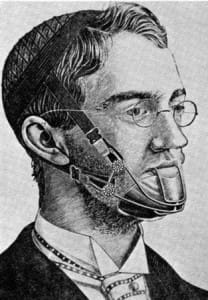When you think of orthodontics “fun” might not be the word that comes to mind – BUT there are some interesting FUN FACTS!
Here are some interesting and quirky “who knew?!” fun facts you can share and impress all your friends with.
Fact #1: All Orthodontists Are Dentists
Do you remember when you learned that “all squares are rectangles, but not all rectangles are squares” in elementary school? This is similar, because an orthodontist is actually a dentist who specializes in the prevention and treatment of malocclusions (misalignments) and other teeth irregularities.
Orthodontists go to dental school and THEN complete an additional two to three years (about 3700 hours of additional training!) in an orthodontic residency program.
About 6% of dentists are orthodontists.
Fact #2: The Word “Orthodontics” Is Of Greek Origin
The Greek words “Orthos” means straight or correct and “donts” (not to get confused with don’t!) means tooth. So, when we put these words together it means straight teeth.
Orthos = straight donts = teeth Orthodontics = straight teeth
Fact #3: Braces Were Invented Over 300 Years Ago
 French physician Pierre Fauchard, known as “the father of modern dentistry,” made the first set of braces in 1728. The braces consisted of a flat piece of metal material connected to the teeth by thread.
French physician Pierre Fauchard, known as “the father of modern dentistry,” made the first set of braces in 1728. The braces consisted of a flat piece of metal material connected to the teeth by thread.
Just shy of 200 years later, dentist Edward Angle made some important advancements to fix problematic tooth alignments more effectively. He is known as the first orthodontist. In fact, he was the first dental professional to limit his practice to just orthodontics.
Edward Angle created brackets in 1915, and used 14 or 18 karat gold because of its malleable properties and was easy to shape into the orthodontic appliances. Dr. Angle also established what is known as the American Association of Orthodontics (AAO) and created the first classifications (which are still used today) to describe the severity of malocclusions (the misalignment of teeth when the jaws close).
Fact #4: The Type Of Wire Used For Braces Was Created By NASA
 Dr. Angle’s developments may have been innovative, but gold braces were also expensive!
Dr. Angle’s developments may have been innovative, but gold braces were also expensive!
Orthodontics took a giant leap when NASA developed a metal alloy called nickel titanium in 1959 for the space program. Although this heat-resistant metal was built for space-bound shuttles, it was also perfect for making thin, highly flexible wires that could maintain their shape.
When used for orthodontic treatment, these wires are activated by a patient’s body heat and maintain their shape once attached to the teeth.
Fact #5: Braces Are Not Just For Straightening Teeth
Although having perfectly aligned teeth is a great part of braces, one of the main benefits is that braces fix a person’s bite.
If your upper front teeth cover your lower teeth and the cusps of your molars don’t touch, you have the perfect dental alignment. Many people do not have this naturally. When braces fix your bite, they also alleviate an array of health problems, including:
- Difficulty speaking
- Breathing issues
- Problems chewing and swallowing
Fact #6: Braces Aren’t Just For Teens And Tweens
The American Association of Orthodontics has reported that about one in five orthodontic patients is an adult.
These days, orthodontic treatments are available for parents, grandparents, and great-grandparents!
On the flip side, can you be too young to start orthodontic treatment? The earlier you get your child in for a consultation, the earlier you’ll know what he or she might need.
The American Association of Orthodontics recommends getting your child into an office by age seven. Certain malocclusions are best treated at a young age. In fact, sometimes seeking orthodontic care for a small child can entirely prevent him or her from needing braces later in life.
Fact #7: Teeth Can Move After Treatment
Despite doctor’s orders, about one-quarter of patients do not wear their post-treatment retainer as advised and later need retreatment for teeth that have shifted back.
That is why it is important to wear your retainer as directed!
Fact #8: About Four Million…
The American Association of Orthodontics has reported that four million people have braces at this very minute. About one million orthodontic patients are adults over the age of 18.
Braces are very popular – and for good reason!
Fact #9: Myth-Busting Facts
If you’re thinking about getting braces, it’s natural to have questions or concerns, but make sure you’re not letting any myths get to you! Here are some myths-busted about braces:
- You can still safely play sports.
- You can still play musical instruments effectively, including ones that use your mouth.
- Braces don’t actually set off metal detectors.
- Braces don’t interfere with radio signals.
- Braces aren’t magnetic.
- It’s not possible to “lock” braces when kissing another person with braces.
Fact #10: New Advances In Technology – All The Time!
While the look of traditional braces hasn’t changed much in the past few decades, many other aspects of orthodontics have. The advancement of technology in the field of orthodontics means that there are quicker treatment times and a better patient experience. Some of these advances include:
- 3-D scanning of teeth: Using a machine like I-Tero gives your orthodontist a digital impression of your teeth for immediate images to make a better fitting retainer with more accuracy.
- Clear Aligners: Aligners like Invisalign give patients the flexibility to have orthodontic treatment with an almost invisible look.
- Digital x-rays and 3D imaging: Gone are the days of taking an x-ray and waiting for it to develop before the doctor can look at it. Digital x-rays allow doctors to evaluate any issues right away. The most popular 3D imaging used is the I-Cat Cone Beam (CBCT). This gives a 360-degree view and creates a 3D image of the patient’s oral formation. This helps to see what is going on under the gums, like impacted teeth or short roots.
We hope you enjoyed some fun facts about orthodontics!
Have questions, want to schedule a free consultation or want to let us know some fun orthodontic facts that you have found give us a call today! (208) 734-4314

